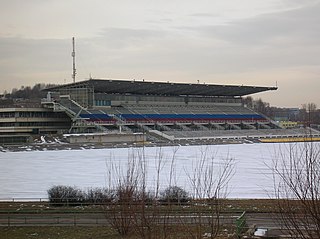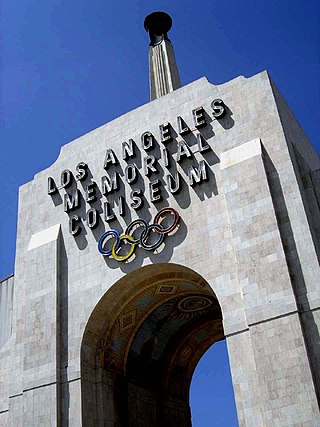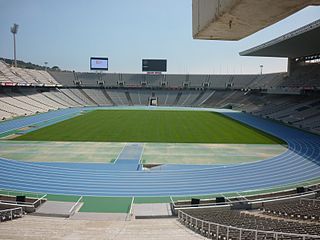Related Research Articles

For the 2000 Summer Olympics, a total of thirty sports venues were used. After Melbourne hosted the 1956 Summer Olympics, Australia made several bids for the Summer Olympics before finally winning the 2000 Summer Olympics by two votes over Beijing, China. Venue construction was set at the Homebush Bay area of Sydney in an effort to rehabilitate the land. Environmental studies of the area in the early 1990s forced remediation to be used for about a fifth of the site selected. Fifteen new venues were constructed for the Games. Many of the venues used for the 2000 Games continue to be in use as of 2020, although some of the pre-existing facilities have been demolished and replaced.
For the 1928 Winter Olympics in St. Moritz, Switzerland, a total of five sports venues were used. The main stadium hosted the figure skating, ice hockey, and speed skating events. Skeleton was first held at the Cresta Run. Bobsleigh was held at the bob run. St. Moritz itself served as cross-country skiing venue and the cross-country part of the Nordic combined event. Weather gave two events run at these games problems, creating the largest margin of victory in Olympic history for one and the cancellation of the other.
For the 1960 Summer Olympics, a total of thirty-four sports venues were used. The Basilica of Maxentius, the Baths of Caracalla, the Appian Way, and Via Cassia were among the ancient Roman venues used for the games. The football stadium in Florence hosted the 1934 FIFA World Cup and would later host the 1990 FIFA World Cup. Stadio Olimpico would later serve host to the 1987 IAAF World Championships in Athletics and the final venue for the 1990 FIFA World Cup. The marathon would be lit at night by Italian soldiers holding torches that included the Appian Way with a finish at the Arch of Constantine.
For the 1964 Summer Olympics, a total of thirty-three sports venues were used. Six of the venues were built before the International Olympic Committee awarded the 1964 Games to Tokyo in 1959. This included two venues that hosted the 1958 Asian Games. There were thirteen new, eight temporary, and five reconstructed and/or renovated venues that were used during the event. During the Olympics, wind and weather had issues with two athletic events. After the Olympics, one venue hosted both a FIFA World Cup and a World Athletics Championship event while another also hosted a World Athletics Championship event.
For the 1968 Winter Olympics in Grenoble, France, a total of ten sports venues were used. Most venues were constructed between the 1964 Winter Games in Innsbruck and the 1968 Games. Thawing was an issue for the four-man bobsleigh run. They were limited to only two runs. Thawing also affected the men's 500 m speed skating event. Electronic timing in alpine skiing affected the results of the women's giant slalom event. It gave Canada's Nancy Greene a headache for two days despite her gold medal in the event.

For the 1968 Summer Olympics, a total of twenty-five sports venues were used. Most of the venues were constructed after Mexico City was awarded the 1968 Games. Mexican efforts in determining wind measurement led to sixteen world records in athletics at the University Olympic Stadium. All four of the football venues used for these games would also be used for both of the occurrences that Mexico hosted the FIFA World Cup, in 1970 and 1986.

For the 1976 Summer Olympics, a total of twenty-seven sports venues were used. Several venues used had been in existence before Montreal made its first Olympic bid in the late 1930s. By the 1950s, Montreal's bid for the Olympics shifted from Winter to Summer before it was finally awarded the 1976 Summer Games in 1970. Strikes in 1974 and 1975 affected construction of the Montreal Olympic Park, most notably the stadium, pool, and velodrome, to the point where the FINA President threatened to not have the diving, swimming, and water polo events take place there for the games in early 1976 though all three venues were completed as best as possible prior to the 1976 Games. 27 swimming world records were set as a result. The oldest stadium, Molson Stadium at McGill University, would be converted into artificial turf for the field hockey tournaments while the sailing program in Kingston, Ontario, would be held in freshwater, both for the first time in Summer Olympic history. Indoor track cycling took place at the Olympics for the first time at the velodrome. Once the Olympics finished, the Montreal Expos and Montreal Alouettes moved into Olympic Stadium, staying until 2004 and 1997, respectively. The Montreal Canadiens remained at the Montreal Forum until they moved to the Molson Centre in March 1996. In 1992, the velodrome was converted into an indoor zoo now known as the Montreal Biodôme. Île-Notre Dame hosted a canoe sprint world championships and two rowing world championships since the 1976 Games, but the area north of the basin on the island has been host to the Formula One Canadian Grand Prix on an almost annual basis since 1978.

For the 1980 Summer Olympics, a total of twenty-eight sports venues were used. The first venue used for the Games was built in 1923. With the creation of the Spartakiad in Moscow in 1928, more venues were constructed. Central Lenin Stadium Grand Arena was built in 1956 for that year's versions of the Spartkiad. A plan in 1971 to construct more sports venues by 1990 was initiated, but accelerated in 1974 when Moscow was awarded the 1980 Games. The new venues to be used for the Games were completed in 1979. During the Games themselves at the permanent road cycling venue, the first ever constructed, the largest margin of victory was recorded in the individual road race cycling event since 1928. The Grand Arena hosted the football final that was played in a rainstorm for the third straight Olympics. After the 1991 break of the Soviet Union, the venues in Kiev, Minsk, and Tallinn would be located in Ukraine, Belarus, and Estonia, respectively. Luzhniki Stadium, formerly Grand Arena, continues to be used, and it was affected by the Luzhniki disaster in 1982. The stadium served as host for the IAAF World Championships in Athletics in 2013. Another venue, the Moscow Canoeing and Rowing Basin, served as host to the ICF Canoe Sprint World Championships in 2014. In December 2010, Russia was awarded the 2018 FIFA World Cup with Luzhniki Stadium and Dynamo Stadium proposed as venues for those events.
For the 1984 Winter Olympics in Sarajevo, Yugoslavia, a total of nine sports venues were used. The idea for the Games came around from a 1968 Organisation for Economic Co-operation and Development study on promoting winter tourism in Yugoslavia. After Sarajevo was awarded the 1984 Games in 1978, venue construction and renovation took place between 1979 and 1983. Weather postponed the men's downhill alpine skiing event three times before it was finally run. The men's cross-country skiing 30 km event was run during a blizzard. After the games, all but one of the venues were damaged during the Bosnian War and the siege of Sarajevo. After the war, Zetra Ice Hall was rebuilt and is in use as of 2010.

For the 1984 Summer Olympics, a total of thirty-one venues were used. The Los Angeles Memorial Coliseum and the Rose Bowl, two venues previously used for the 1932 Summer Olympics, were used for the 1984 Games. Between the 1932 and the 1984 Summer Olympics, the expansion of professional sports teams assisted in the growth of the facilities that would be used for the 1984 events. Only two new permanent venues were constructed, both using corporate sponsorship, though neither were mentioned in the official Olympic report. Many other venues had temporary adjustments and returned to their normal usage once the 1984 Olympics were completed. Stanford Stadium in Palo Alto and the Rose Bowl later served as venues for the Super Bowl, the FIFA World Cup, and the FIFA Women's World Cup.

For the 1988 Winter Olympics in Calgary, Alberta, Canada, a total of nine sports venues were used. Calgary tried twice to host the Winter Olympics in the 1960s without success before finally winning the 1988 Winter Games in 1981. Stampede Corral was built in 1950 while McMahon Stadium was built in 1960. When the National Hockey League (NHL) Flames franchise was relocated from Atlanta, Georgia in the United States during the summer of 1980, a new arena was needed. The Saddledome construction was underway in late 1981 when Calgary was awarded the 1988 Games. Completed in 1983, the Olympic Saddledome has played host to the Flames ever since, including three Stanley Cup Finals and the NHL All-Star Game in 1985. An innovation for the games was the first indoor long-track speed skating venue which has served as a model for future Olympics. The bobsleigh and luge track was the first combination track in North America and was noted for the Jamaican bobsleigh team crash during the four-man event. Both the Oval and the bobsleigh/luge track continue to host the World Championships in their respective sports since the 1988 Winter Olympics.
For the 1992 Winter Olympics in Albertville, France, a total of thirteen sports venues were used. Val-d'Isère has been part of the Alpine Skiing World Cup since the late 1960s while Tignes served as host of the first Freestyle World Ski Championships in 1986. Most of the venues used were constructed between 1987 and mid 1990 with the test events taking place in late 1990 and early 1991. It was the last Winter Olympics with an outdoor speed skating rink which led to weather issues for three of the ten events. Three cross-country skiing events were run in snowstorms while the men's 20 km biathlon was found to be 0.563 km (0.350 mi) too short. The downhill events in alpine skiing were criticized for being too steep. Freestyle skiing made its official debut at these games with the men's winner being stormed after his win while the women's winner won her event in a snow storm. La Plagne hosted the skeleton World Championships in 1993 while Val-d'Isère hosted the Alpine World Ski Championships in 2009.Some of the venues will be used again during the 2030 Winter Olympics,when the main host city will be Nice.

For the 1992 Summer Olympics in Barcelona, a total of forty-three sports venues were used.
A total of twenty-nine sports venues were used for the 1996 Summer Olympics.

For the 1998 Winter Olympics in Nagano, Japan, a total of fifteen sports venues were used. Nagano had attempted twice to host the Winter Olympics, losing out to Sapporo, host of the 1972 Winter Olympics. The third time, in 1991, Nagano edged out Salt Lake City to host the 1998 Games. The biathlon venue was adjusted in accordance with the Washington Convention over endangered species. The biggest venue controversy was at Happo'one resort on the length of the men's downhill and the battle that ensued to the point where skiing officials threatened to pull the event entirely before a compromise was reached three months before the Olympics. M-Wave has hosted three World Speed Skating Championships since the Olympics, while the Spiral has hosted a couple of world championships in bobsleigh, luge and skeleton.

For the 2004 Summer Olympics, a total of thirty-five sports venues were used. Athens hosted the first modern Olympic Games in 1896, which used venues such as Panathinaiko Stadium and the city of Marathon for which the long-distance race would be named. From the end of the 1896 Games until the late 1970s, Greece underwent numerous political changes that included the Balkan Wars, two World Wars, a civil war, and a military coup that resulted in a junta that lasted from 1967 to 1974. A change in democracy in 1975 resulted in Greece's admission into the European Economic Community in 1979.

For the 2006 Winter Olympics in Turin, Italy, a total of fifteen sports venues were used. Venue construction ran from 2002 to 2005. Cesana Pariol had to have turns 17 and 18 modified following the Luge World Cup in January 2005, but they were not cleared out until October 2005. Winds postponed the Nordic combined team event for a day. Many of the venues served as host for the Winter Universidade the following year.
References
- 1 2 1988 Summer Olympics official report. Volume 1. Part 1. p. 166. Retrieved 1 December 2010.
- 1 2 1988 Summer Olympics official report. Volume 1. Part 1. p. 164. Retrieved 1 December 2010.
- 1 2 3 4 5 1988 Summer Olympics official report. Volume 1. Part 2. p. 335. Retrieved 2 December 2010.
- ↑ 1988 Summer Olympics official report. Volume 1. Part 1. pp. 162-3. Retrieved 1 December 2010.
- ↑ 1988 Summer Olympics official report. Volume 1. Part 1. p. 181. Retrieved 1 December 2010.
- ↑ 1988 Summer Olympics official report. Volume 1. Part 1. p. 178. Retrieved 1 December 2010.
- ↑ 1988 Summer Olympics official report. Volume 1. Part 1. pp. 178-9. Retrieved 1 December 2010.
- ↑ 1988 Summer Olympics official report. Volume 1. Part 1. p. 180. Retrieved 1 December 2010.
- 1 2 1988 Summer Olympics official report. Volume 1. Part 1. p. 176. Retrieved 1 December 2010.
- ↑ 1988 Summer Olympics official report. Volume 1. Part 1. pp. 190-1. Retrieved 1 December 2010.
- ↑ 1988 Summer Olympics official report. Volume 1. Part 1. pp. 186-7. Retrieved 1 December 2010.
- 1 2 1988 Summer Olympics official report. Volume 1. Part 1. p. 194. Retrieved 1 December 2010.
- 1 2 1988 Summer Olympics official report. Volume 1. Part 1. p. 192. Retrieved 1 December 2010.
- ↑ 1988 Winter Olympics official report. Volume 1. Part 1. pp. 188-9. Retrieved 1 December 2010.
- ↑ 1988 Summer Olympics official report. Volume 1. Part 1. p. 195. Retrieved 1 December 2010.
- ↑ 1988 Summer Olympics official report. Volume 1. Part 1. p. 200. Retrieved 1 December 2010.
- 1 2 1988 Summer Olympics official report. Volume 1. Part 1. p. 202. Retrieved 1 December 2010.
- 1 2 3 1988 Summer Olympics official report. Volume 1. Part 1. p. 206. Retrieved 1 December 2010.
- ↑ 1988 Summer Olympics official report. Volume 1. Part 2. p. 311. Retrieved 1 December 2010.
- 1 2 3 4 1988 Summer Olympics official report. Volume 1. Part 1. pp. 200-1. Retrieved 1 December 2010.
- 1 2 1988 Summer Olympics official report. Volume 1. Part 1. p. 204. Retrieved 1 December 2010.
- ↑ 1988 Summer Olympics official report. Volume 1. Part 1. pp. 202-3. Retrieved 1 December 2010.
- ↑ 1988 Summer Olympics official report. Volume 1. Part 1. pp. 204-5. Retrieved 1 December 2010.
- 1 2 3 History of Dongdaenum Stadium: 1926-2003. Retrieved 2 December 2010. (in Korean)
- ↑ Worldstadiums.com profile in Busan, KOR. Archived 26 March 2015 at the Wayback Machine Retrieved 2 December 2010.
- ↑ Daegu.go.kr profile of Daegu Stadium. Retrieved 2 December 2010. (in Korean)
- ↑ Djsiseol.or.kr history of Daejeon Stadium. Retrieved 2 December 2010. (in Korean)
- ↑ 1988 Summer Olympics official report. Volume 1. Part 1. p. 33.
- ↑ todor66.com profile of the 1979 FIBA Women's World Basketball Championship results. Archived 27 May 2009 at the Wayback Machine Retrieved 2 December 2010.
- ↑ 1988 Summer Olympics official report. Volume 1. Part 1. pp.34-43. Retrieved 2 December 2010.
- 1 2 1988 Summer Olympics official report. Volume 1. Part 1. p. 159. Retrieved 2 December 2010.
- 1 2 1988 Summer Olympics official report. Volume 1. Part 1. 172, 174, 186-206. Retrieved 2 December 2010.
- ↑ OCAsia.org profile of the 1986 Asian Games. Archived 7 November 2010 at the Wayback Machine Retrieved 2 December 2010.
- ↑ Wallechinsky, David and Jaime Loucky (2008). "Track & Field (Men): Marathon". In The Complete Book of the Olympics: 2008 Edition. London: Aurum Press Limited. pp. 149-50.
- ↑ Wallechinsky, David and Jaime Loucky (2008). "Canoeing: Men's Kayak Singles 1000 Meters". In The Complete Book of the Olympics: 2008 Edition. London: Aurum Press Limited. p. 472.
- ↑ Wallechinsky, David and Jaime Loucky (2008). "Rowing: Men's Four-Oared Shell Without Coxswain". In The Complete Book of the Olympics: 2008 Edition. London: Aurum Press Limited. pp. 796-7.
- 1 2 Wallechinsky, David and Jaime Loucky (2008). "Sailing: Men's Finn". In The Complete Book of the Olympics: 2008 Edition. London Aurum Press Limited. p. 827.
- 1 2 "Lemieux's sportsmanship still recognized". Archived 28 June 2011 at the Wayback Machine Canada.com 13 March 2008 Edmonton Journal article Retrieved 2 December 2010.
- ↑ 1988 Summer Olympics official report. Volume 2. Part 2. p. 692. Retrieved 2 December 2010.
- ↑ Sports-reference.com 1988 Summer Olympics sailing mixed-one-person-dinghy (Finn) class 24 September Race Five results. Retrieved 2 December 2010.
- ↑ Wallechinsky, David and Jaime Loucky (2008). "Tennis: Women's Singles". In The Complete Book of the Olympics: 2008 Edition. London: Aurum Press Limited. p. 1027.
- ↑ Stadium.seoul.go.kr profile of Olympic Stadium. Retrieved 2 December 2010.
- ↑ FIFA.com 2002 FIFA World Cup information. Retrieved 2 December 2010.